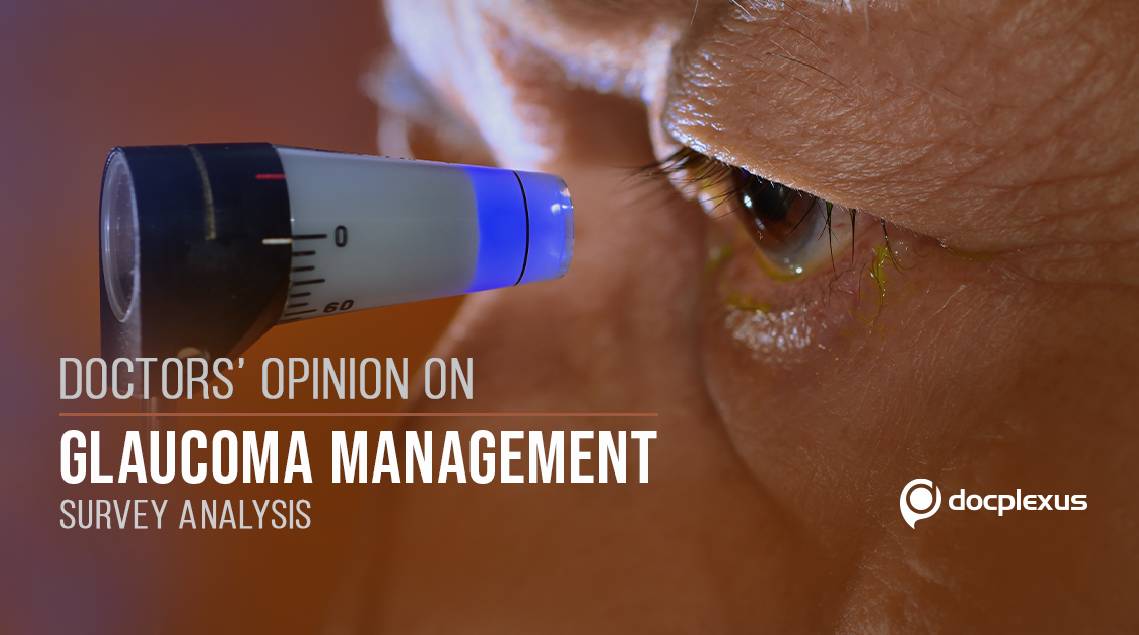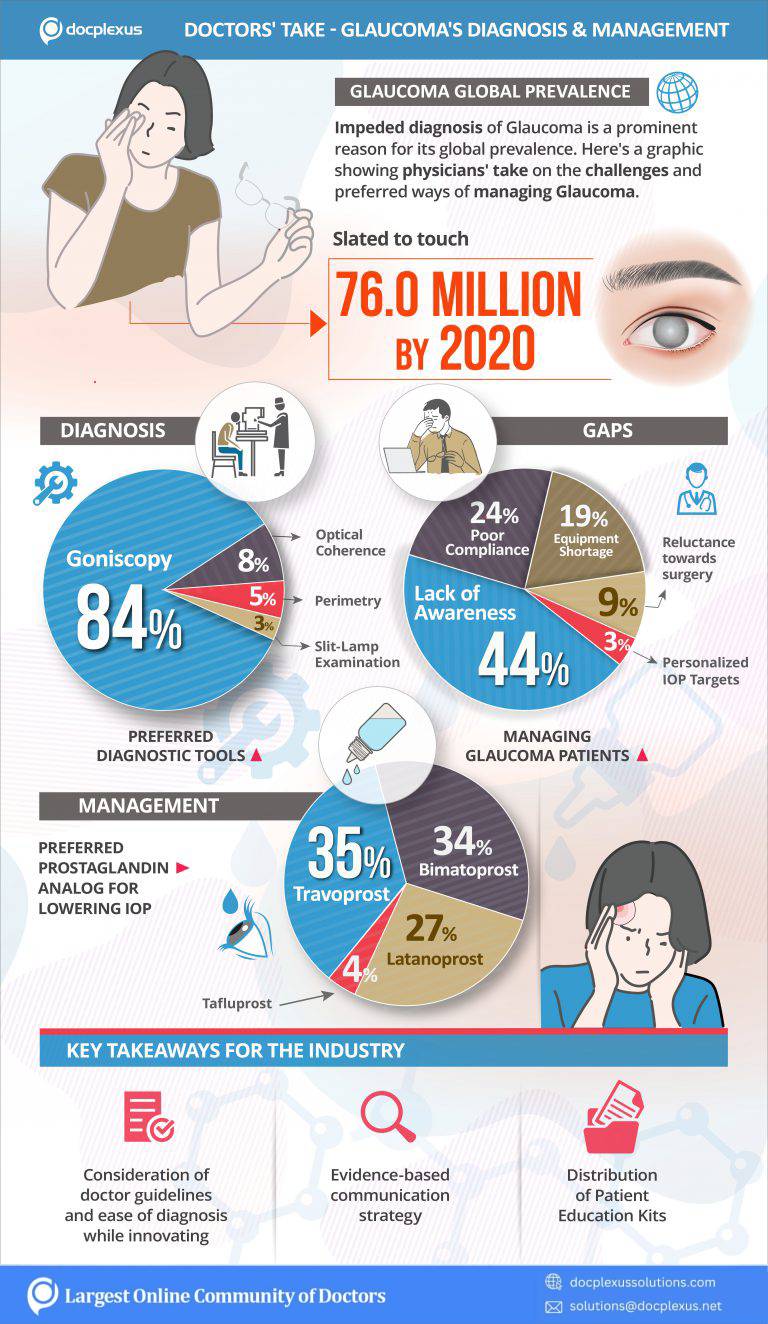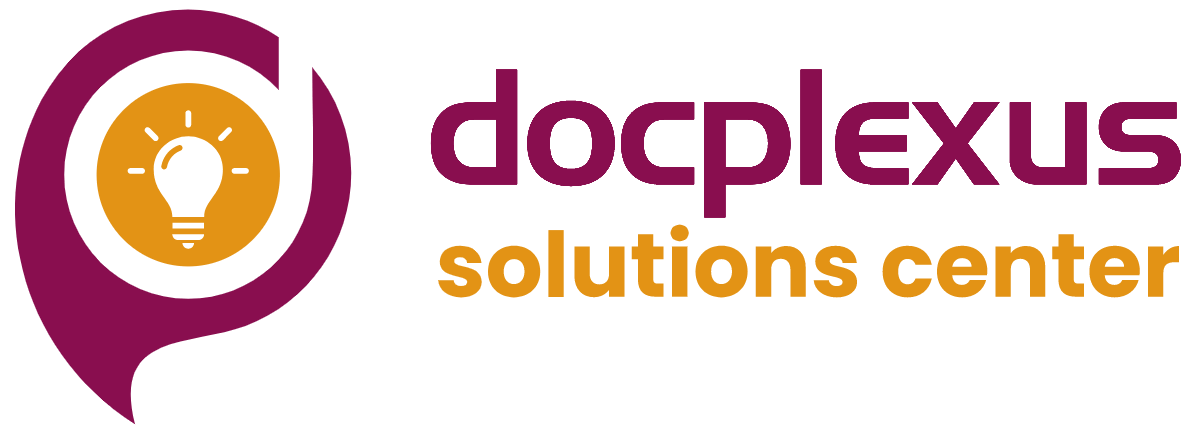
Glaucoma is a group of heterogeneous disease which posses a significant burden on a patient’s quality of life (QoL). In 2013, the global prevalence of glaucoma was 64.3 million and this number is estimated to increase to 76.0 million by 2020. This ever-increasing incidence rate of glaucoma can be attributed to the delayed diagnosis of glaucoma due to its asymptomatic presentation. Pharma through its innovations can help in early and effective diagnosis of glaucoma by improving the QoL of patients.
Survey Details
Aim: To understand Doctors’ Viewpoint on Diagnosis and Management of Glaucoma
Methodology: A nationwide online poll on Docplexus
Respondents: 121, including Ophthalmologists, Pediatric Ophthalmologists, and Consulting Physicians.
Survey Results

Analysis
Early Detection is the ‘Key’ for Reducing the Incidence of Glaucoma
Early detection of glaucoma (open and closed-angle) is key in reducing irreversible vision loss as it enables the appropriate monitoring and treatment of patients.
A recent article published in the review of ophthalmology states that gonioscopic examination is the gold standard for the diagnosis of primary closed-angle glaucoma (PCAG). According to our survey findings, 84% of doctors opined their view in favor of gonioscopy being the choice for the diagnosis of PCAG, whereas only 3-8% of doctors mentioned that they preferred other diagnostic tools (i.e. slit-lamp examination, perimetry and optical coherence tomography) over gonioscopy. The high rate of acceptability of gonioscopy over other diagnostic tools could be accounted for its ability to provide a rapid 360° assessment of the eye.
Perimetry or visual field examination forms the cornerstone for the diagnosis of primary open-angle glaucoma (POAG). This is in accordance with guidelines from various associations as the American Optometric Association (AOA) and the National Institute for Health and Care Excellence (NICE). As per our survey, around 64% of doctors were in favor of recommendations by the above guidelines. Furthermore, 17-18 % of doctors felt that optic disk photography (ODP) or optical coherence tomography (OCT) would be better suited for the diagnosis of POAG. The reason behind these varied sentiments was clinical pieces of evidence that showed that assessment of optic nerve (through OCT/ODP), along with perimetry provided complimentary clues for the diagnosis of POAG.
Considering the above viewpoint of doctors, it can be said that when diagnosing a disease, doctors follow guidelines, consider the assessment ability of a diagnostic tool and at the same time use their clinical experience when confirming the diagnosis of a disease. Thus in this regard, Pharma should consider guidelines, view of the medical community, and ease of disease diagnosis when innovating future medical devices for diagnosis of glaucoma.
Efficacy of Treatment is of Utmost Importance
An antiglaucoma agent acts on the aqueous humor dynamics to reduce the intraocular pressure of the eye. Drug classes that are commonly used for management of glaucoma include prostaglandins (PGAs), β-adrenergic blockers, α-adrenergic blockers, carbonic anhydrase inhibitors, and topical cholinergic agonists. Insights from our survey indicated that around 70% of doctors preferred prostaglandins over other classes of drugs. Furthermore, Travoprost (34%) and Bimatoprost (34%) were seen to the most opined PGA when compared to latanoprost (27%). The above results were consistent with various clinical trials which showed that:
i) Prostaglandins had greater ability to reduce intraocular pressure than anti-glaucoma agents
ii) Travoprost and Bimatoprost reduce IOP to a greater extent than latanoprost.
In view of the above treatment outlook, it is quite evident that doctors practice evidence-based medicine when treating a patient. Consequently, Pharma should start considering a lookout for product communications strategies that focuses more on the results of a clinical trial and meta-analysis when demonstrating the efficacy and safety of a medication.
Identifying and Overcoming Treatment Challenges in Glaucoma is Crucial
Challenges in the management of glaucoma are diverse and are as follows:
i) Early detection and diagnosis of disease
ii) Setting up of appropriate IOP targets
iii) Lack of glaucoma awareness
iv) Treatment noncompliance
Our survey results demonstrated that 44% of doctors feel that lack of glaucoma awareness is the prime challenge that hinders effective management of glaucoma while others feel that treatment noncompliance (24%), early detection and diagnosis of disease (19%) due to a dearth in diagnostic equipment needed for early diagnosis along with difficultly in setting up appropriate IOP targets (9%) also have a role to play in disease progression due to its delaying remission.
To conclude, medical professionals feel that patient education is of utmost importance to ensure compliance and ensure early detection of disease (informed patient more likely to present themselves to a clinic). In this respect, a patient education kit (PEK) can be a valuable tool for a doctor to address the issue of raising awareness among patients. Pharma marketers can play its part by providing doctors with such PEKs. This, in turn, will help pharma differentiate themselves from their competitors and strengthen their relationship with their customers.
Final Thoughts
Physicians and pharma form the main players in the effective management of glaucoma. A knowledge of insights from the medical fraternity can help pharma strategize their medical innovations for better treatment outcomes in glaucoma patients. This ultimately will help pharma gain strong followership among doctors.
Docplexus – Pharma’s Trusted Marketing Partner
Docplexus is the largest digital network of doctors in India & a trusted marketing partner of pharma & medical device companies. We empower our industry partners to meaningfully engage with the medical community through data-driven, evidence-based marketing & brand management solutions such as Infocenters, Mindset Analysis, KOL Webinars, Sponsored Medical Updates, Online CMEs & more.
You can reach us at: solutions@docplexus.net
